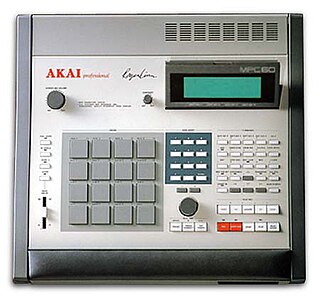A music workstation is an electronic musical instrument providing the facilities of:

The Roland MC-303 is the first of a series of musical instruments known as a groovebox. It combines a simple sound module with a sequencer to record and store notation, along with controls aimed at encouraging the musician to improvise the music while it is playing. Despite the number in its name and the attention it received at its launch, the MC-303 has more in common with other MC prefixed synthesizers, which contain built-in sequencers, than it does with the famous Roland TB-303. As the first Groovebox, the MC-303 was the first in a line of inexpensive products specifically targeted towards house DJs and amateur home musicians rather than professional producers. It was superseded by the Roland MC-505. It is the predecessor to the Roland JX-305, Roland D2, Roland MC-307, Roland EG-101, Roland MC-09, Roland MC-909, Roland MC-808, and most recently the Roland MC-707 in 2019, along with its more portable sibling, the Roland MC-101.

Novation Digital Music Systems Ltd. is a British musical equipment manufacturer, founded in 1992 by Ian Jannaway and Mark Thompson as Novation Electronic Music Systems. Today the company specializes in MIDI controllers with and without keyboards, both analog and virtual analog performance synthesizers, grid-based performance controllers, and audio interfaces. At present, Novation products are primarily manufactured in China.
The Nord Lead is a series of virtual analog subtractive synthesizers, manufactured by Clavia.

The Emulator is a series of digital sampling synthesizers using floppy-disk storage that was manufactured by E-mu Systems from 1981 until 2002. Although it was not the first commercial sampler, the Emulator was innovative in its integration of computer technology and was among the first samplers to find widespread usage among musicians. While costly, its price was considerably lower than those of its early competitors, and its smaller size increased its portability and, resultantly, practicality for live performance. The line was discontinued in 2002.

The Akai MPC is a series of music workstations produced by Akai from 1988 onwards. MPCs combine sampling and sequencing functions, allowing users to record portions of sound, modify them and play them back as sequences.

The Roland JP-8000 is an analog modeling synthesizer released by the Roland Corporation in 1996.

Waldorf Music is a German synthesizer company. They are best known for the Microwave wavetable synthesizer and Blofeld virtual analogue synthesizer.

The Korg Prophecy is considered one of the earliest (mid-nineties) virtual analog synthesizers, although its synthesis capabilities went beyond many of its VA contemporaries.

The Korg Trinity is a synthesizer music workstation released by Korg in 1995. It was also the first workstation to offer modular expansion for not only sounds, but also studio-grade feature such as ADAT, various sound engine processors, audio recording capability, and more. It was considered one of the most comprehensive music workstations, in term of features, at the time.

The Korg X3 is a music workstation produced by Korg in 1993. The X3 features 200 programs, 200 combinations, 32-voice polyphony, a 32,000 note, 16-track sequencer with 100 patterns and 10 songs and a double-sided, double-density 3.5-inch floppy disk drive for song and other data storage types. Korg also released the X2 (76-key) with 8 Mbyte ROM in 1994 along with a rackmount version dubbed the X3R, which also had a floppy disk drive.
The Yamaha SY85 is a digital music workstation introduced in 1992. Unlike other Yamaha synthesizers of the time the SY85 does not use FM synthesis. Instead, its sounds are based on samples, which can be layered and modified to create new sounds.

Quasimidi Musikelektronik GmbH was a German synthesizer manufacturer from Hesse. It was founded in 1987 by Friedhelm Haar and Jörg Reichstein. It was originally based in Kirchhain, but moved to Rauschenberg in 1998. The company folded in 2000.

E-mu Systems was a software synthesizer, audio interface, MIDI interface, and MIDI keyboard manufacturer. Founded in 1971 as a synthesizer maker, E-mu was a pioneer in samplers, sample-based drum machines and low-cost digital sampling music workstations.
The Korg Kaossilator is a line of portable music synthesizers manufactured by Korg. Termed "dynamic-phrase synthesizers" by the manufacturer, Kaossilators are capable of producing a wide range of sounds, can produce a continuous music loop, and can be tuned to various keys and scales.
The Yamaha EX5 is a synthesizer/workstation produced by Yamaha from 1998 to 2000. The EX5 combines several methods of sound generation. The later released EX7 was a cheaper version of the EX5 with fewer keys, polyphony, sounds and functions. The Yamaha EX music synthesizers, along with the early Yamaha S series, were the predecessors of the Motif workstation series.
Red Sound Systems are a British manufacturer of music equipment. In the past, the company has manufactured the Darkstar and optional Vocoda kit, the Darkstar XP2 and Elevata synthesizers. The company has also manufactured DJ equipment such as the Federation BPM FX Pro and the Beat Xtractor1.
The Roland V-Synth is a polyphonic synthesizer. It was released 2003 and was Roland's flagship synthesizer at the time. It combines multiple oscillator technologies and a built in sampler. It also features an arpeggiator and COSM filtering to aid the creation of new sounds.
The miniKORG is a two VCO monophonic analog synthesizer that was released in 1972 from Korg. It featured 37 keys, three ring modulators and built in analogue effects. It has wooden side panels and all the controls for the unit are not on the front panel but on the side facing the player. It was considered to be stable, affordable and sounded great.

















